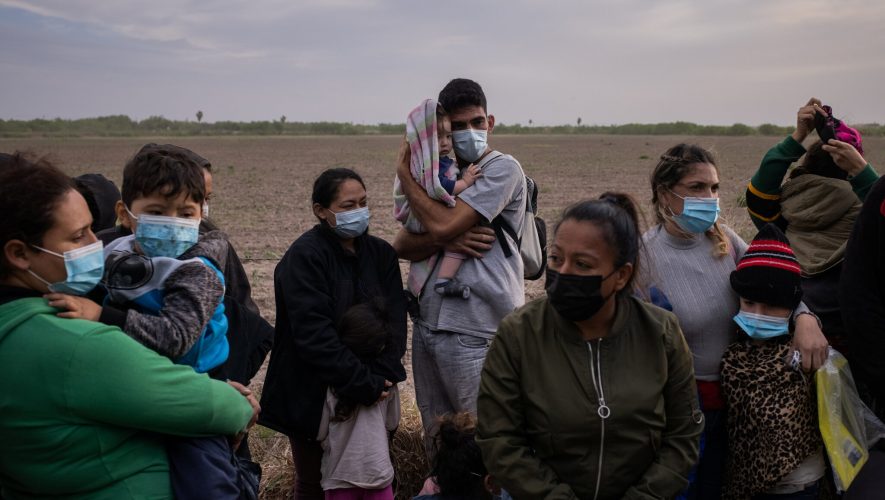Contrary to the one hundred thousand migrants who crossed the United States’ southern border in February alone, I didn’t have to work, starve, or risk my or my children’s life for opportunity. And yet, as a politically active and aware Mexican-American woman, I struggle to find ways to cope with feeling helpless as two parts of my identity clash against one another.
I grew up as a minority within a minority. I not only had a house, but I also had a home. I not only had a school, but I also received an education. I spoke Spanish and English. I was Mexican, but also American; and that—being American—came with many benefits. One such benefit was not being turned away at the border for being a burden to America, rather than an asset.
Today, America faces an immigration problem that has been ongoing for decades. Contrary to popular opinion, this so-called “migration crisis” did not start with President Trump and will not end with President Biden. The situation today is much harder to resolve than some anticipate. Immigrants are vital players in the US economy that simply cannot be disregarded; mistreating them at the border goes against the very values the country cherishes.
While the last president characterized asylum seekers as people who drain public resources and damage the national workforce, the American economy has come to depend on immigrants.
Immigrants have a positive impact on long-run economic growth. In 2020, 17 percent of the US workforce were immigrants, many of whom respond to the demand for low-skilled labor that natives are unable or unwilling to fill. By taking on challenging circumstances— working odd hours or in dangerous environments—immigrants enable Americans to take on higher-paying jobs.
Regardless of immigration status, these foreign laborers make up a significant portion of a shrinking workforce. Some are entrepreneurial, establishing small-scale restaurants, hotels, and grocery stores. Their companies contribute on average $11.64 billion, or around eight percent of their total income in state and local taxes annually.
As such, immigrants are now ingrained in American life. At this point, pushing them away would only undermine the country. Immigration is not a partisan issue; the question is no longer whether one party’s policies grant access to foreigners, but whether America can function without an active flow of immigrants.
Seven years ago, the Obama administration warned of a national crisis at the border. But asylum seekers, especially children, from Latin American countries, particularly those from Central America’s Northern Triangle—Honduras, Guatemala, and El Salvador—continue to arrive in astounding numbers.
Government statistics show that an additional 20,000 children and teenagers are in the custody of a system already at “103 percent capacity.” Other reports indicate that by June, an additional 35,000 migrant children will arrive at the border. To add to the burden, processing asylum seekers—most of whom have waited years for refuge—takes time; over 25,000 migrants, of which 19,000 are children, currently remain scattered along the border between Matamoros and Tijuana.
When he took office, Biden vowed to roll back Trump’s zero-tolerance policy on immigration; his administration committed to stopping family separations and is very critical of holding children in “cages.” He also committed to reversing harmful immigration policies by ending the discriminatory travel ban, protecting Deferred Action for Childhood Arrival (DACA) recipients, and temporarily stopping the construction of the US-Mexico border wall. While Biden vowed to fix the immigration crisis, the US has ironically observed the largest flow of Mexican migrants since the early twentieth century.
As good as Biden’s pledges sound, Mexican President Andres Manuel Lopez Obrador blames Biden for the “crisis,” pointing to how his policies encouraged more migrants to move to the US. As an ultra-left populist leader who developed a win-win relationship with Trump, it comes as no surprise that Obrador critiques Biden’s handling of the border situation. However, Obrador has also sympathized with the view of many undocumented immigrants: “they see Biden as the migrant president” and expect to be welcomed with “open arms.”
Unlike Biden, Trump established some of the cruelest anti-migration policies in decades. Under his administration, the Supreme Court issued an unsigned order practically denying all Central American’s asylum. Only individuals whose asylum claims are denied elsewhere, are from countries that fundamentally lack human rights, or are victims of human trafficking could apply for asylum.
Trump also signed several executive orders in his first week, indicating the administration’s position on immigration early on. These orders largely undermined human rights by expanding the use of detention centers, denying asylum seekers entry into the country, strengthening enforcement of border measures along the US-Mexico border, and constructing a two thousand mile wall.
Trump’s immigration policies centered around an anti-immigrant, white-nationalist agenda, while Biden stresses defending the democratic rights of immigrants as an imperative piece of his socialist revolution. Sadly, neither has successfully put an end to the “crisis,” and therein lies the point: neither party is serious about accepting and integrating immigrants despite this being in the nation’s interest.
Trump’s policies were clearly damaging, but Biden’s actions contradict his vision to move away from his predecessor’s policies. The administration has responded with some of the same tactics that evoked moral outrage from the left under Trump, including accommodating children into “crowded cages” with little to no access to showers, clean clothes, food, heating, or a place to sleep. Democrats who once strongly criticized the Trump administration’s strident policies are now in a political bind.
Upon backlash from Republican leaders denouncing the “Biden border crisis,” the administration argued that the crisis is not expanding, but instead under reconstruction. Thus far, the administration has turned away around 40 percent of families and practically every adult seeking asylum. The Immigration and Customs Enforcement (ICE) agency made these dismissals under Title 42, the same provision the Trump administration used for legal deportations at the beginning of the COVID-19 pandemic.
So far, Americans have reacted negatively to how the administration is handling arrivals of unaccompanied children at the southern border. One poll showed that around 60 percent of Americans prioritized reuniting families and focusing on the safe treatment of children at the border. Around 25 percent of respondents approve of the administration’s actions regarding immigration, while 40 percent disapprove of the current response.
The Biden administration’s first test will be the Department of Health and Human Services’ response. Susan Rice, director of the Domestic Policy Council, and Amy Pope, the president’s senior adviser for migration issues, are aggressively pressing officials from the health department and other immigration agencies to explain the failure to quickly move more than four thousand migrant children out of jail-like detention facilities.
Another test will be laying the groundwork for legal immigration. The administration continues to tell migrants not to come while simultaneously assuring that it will soon establish a system that allows asylum seekers to file claims from their home countries. In March, as part of its immigration plan, the administration offered eleven million undocumented immigrants living in the US an eight-year path to citizenship if they were in the country by January 1. Immigrants will be required to pass background checks and demonstrate that they’ve paid taxes for five years. Afterwards, migrants can apply for a green card that grants them permanent citizenship.
To address the core issue, Biden’s administration says it will provide aid to Central America to target high-level corruption, setting up regional facilities to process legal claims, and reinventing refugee processes for children. The administration is currently working across departments and agencies to help children contact their relatives, and is spending sixty million dollars a week to shelter unaccompanied teenagers and minors.
The pandemic exacerbates the problem. It has left tens of thousands of migrants stranded and displaced due to changes in travel restrictions, employment, and income. Calling the current border issue a “crisis” both exaggerates and understates the reality. It points to the fact that the system itself is broken.
The current situation at the border is harming the safety of immigrants and Americans alike, working against our economic growth. Mishandling this crisis will lead to greater political and humanitarian ramifications for both immigrants and democratic governments.
Immigration is not a partisan issue—in the US, it is a complicated, inflexible, and outdated mess.
There are two sides to this issue. On the one hand, immigrants like me make up 13.7 percent of America. Our accomplishments and space within the country are praised, applauded, and welcomed. On the other hand, many other migrants are starving and dying in overcrowded detention centers. They dream of living in the US but are turned away.
Whether out of nationalist sentiment, xenophobia, or fear of change, America has turned its back on its ideals and single-handedly selected participants to form the country. America is sustained and maintained by immigrants. The issue is not a Democrat or Republican one, but one that all Americans must tackle.
As a first-generation Mexican-American, I will not stand by and watch while freedom, democracy, and justice are stripped away by our nation’s leaders, and you shouldn’t either.



